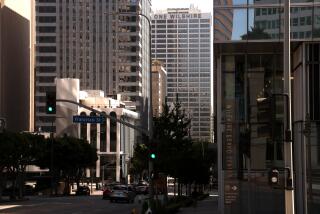COUNTYWIDE : Gated Communities Called Data-Age Foe
Orange County’s gated residential communities foster attitudes and lifestyles that run counter to trends in the information age, a prominent urban planner told a major transportation conference on Tuesday.
“While there may be indeed rapid changes in technology and the economy, the question should center on the person undergoing the change. Is there a new global person emerging?” asked Marc Futterman, director of urban design and planning at the Urban Innovations Group, an adjunct of UCLA.
Futterman made his remarks at a two-day conference on telecommuting. Working at home or at remote, computerized work centers will play a key role in future “information cities,” which are local economies, with the exchange of information as the key commodity.
Telecommuting is conducive to creation of information cities because people who work at home or at remote sites are more efficient and have more time to think creatively, its promoters argue.
But Futterman told an audience of about 100 people that Southern California is not yet the “information city” that futurists have predicted.
“Some areas of the region seem to nostalgically hark back to a fictitious idea about a quite simpler time, but in a more pernicious form--the single-family house in the gated community,” Futterman said. “Orange County is littered with these. The word ‘community’ is in this case, of course, a euphemism for the old, exclusionary tract.”
The result, Futterman said, is a region with Third World problems of no affordable housing, an undereducated underclass, and the “not-in-my-back-yard” syndrome. To this list he added “increasing racism and an impending failure of government to provide the public investment and administration to balance marketing inequities.”
What’s needed, Futterman suggested, are more open communities where people can live and work collaboratively in the same neighborhoods, both in front of and away from computers. Gated communities, both literally and symbolically, segment the population and keep apart people who should otherwise be interacting.
Futurists envision “information cities” based on designs influenced by how information moves. That leads to people sharing ideas via computers and living close to other people involved in similar work in a campus-like setting.
In Japan, Futterman said, a model, “knowledge-based” city is being built where information exchange is the key and people with similar interests live and work in the same place.
Futterman was one of several speakers who wrapped up a two-day conference on telecommuting held by the UC Irvine Institute of Transportation Studies and UCI Extension.
Most of the final day of the conference was spent analyzing studies that show telecommuting does reduce travel and, thus, smog.
During a demonstration project involving state government workers in Sacramento, for example, average vehicle miles traveled dropped from 53.6 miles to 11.7 miles on days when participants telecommuted.
Still, researchers attending the conference said that they aren’t yet able to accurately predict how many people will telecommute, because of resistence from employers and unresolved issues such as potential friction between someone working at home and members of the same family.
Home offices have to be private, conference participants said. “We don’t know if the divorce rate or the birth rate will increase,” said Cy Ulberg, a researcher at the Washington State Transportation Center.
More to Read
Sign up for Essential California
The most important California stories and recommendations in your inbox every morning.
You may occasionally receive promotional content from the Los Angeles Times.










